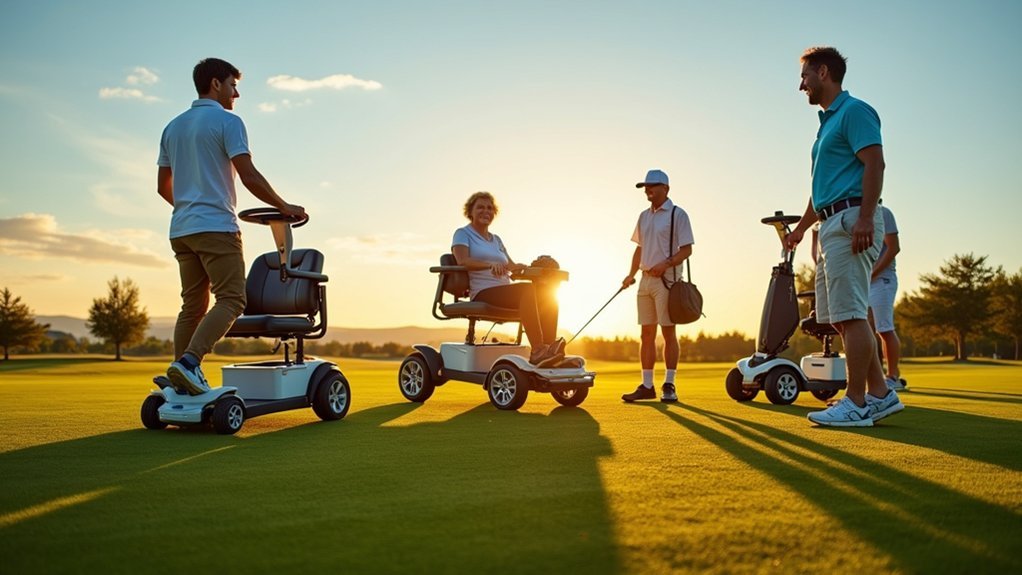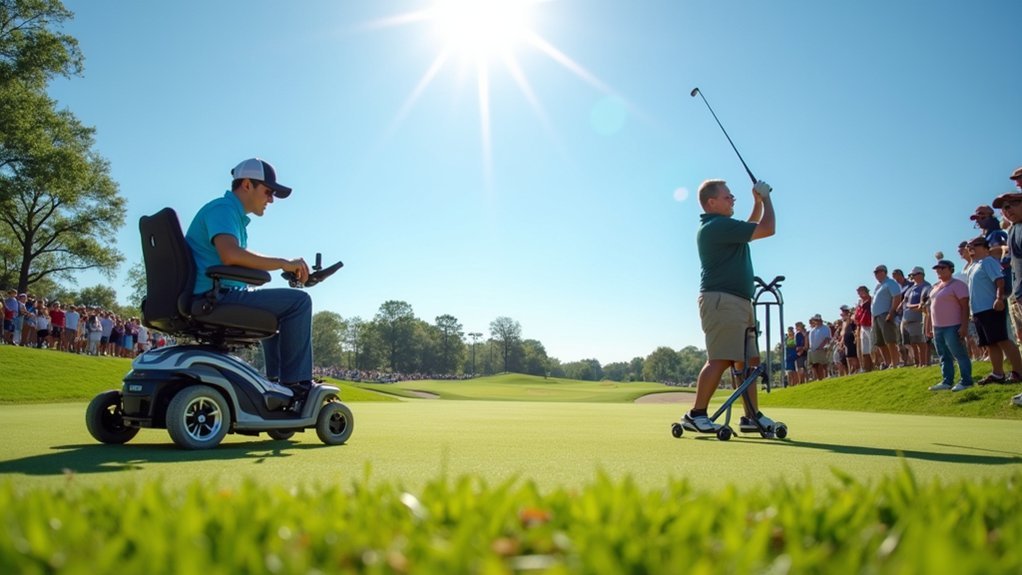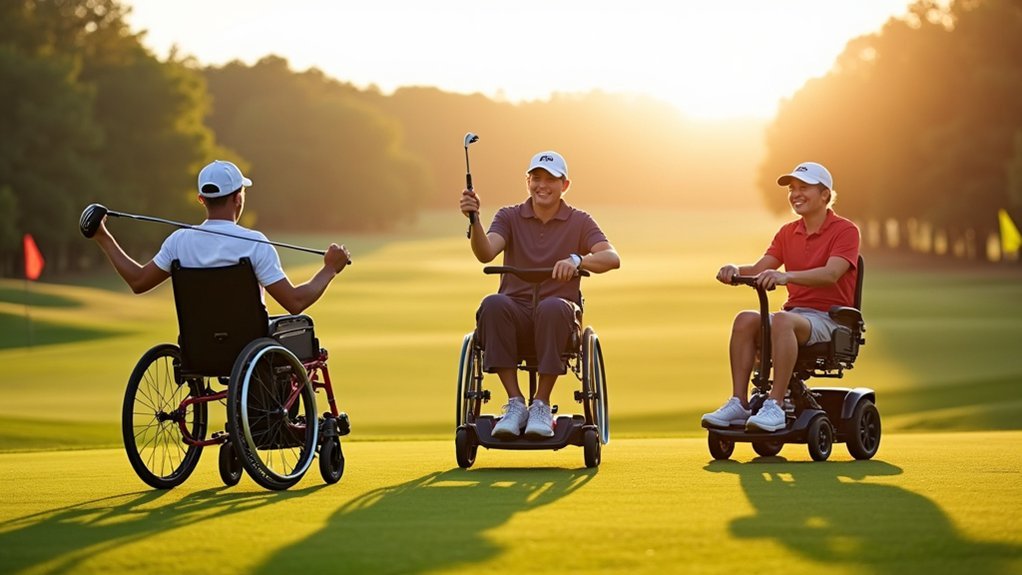Modern mobility devices have revolutionized golf accessibility with specialized wheelchairs, adaptive carts, and stand-up systems that feature pivot-in-place technology and turf-friendly tires. You’ll find modified rules that accommodate your needs, including expanded relief options and bunker access allowances. Training with adaptive equipment can enhance your game while connecting you to supportive communities. Financial assistance programs help offset equipment costs. The fairways await as golf becomes a truly inclusive sport for all players.
The Evolution of Mobility Devices in Golf

Since the early days of golf’s storied history, the sport has undergone remarkable transformations to become more inclusive, particularly through the development of mobility devices.
You’ll find that today’s assistive technology revolutionizes accessibility on courses worldwide, with innovations like wheelchairs, buggies, and the VertaCat electric stand-up system.
Modern mobility devices feature sophisticated engineering like pivot-in-place positioning and anti-jerk acceleration, empowering players with disabilities to navigate courses with unprecedented ease.
Today’s adaptive golf technology brings freedom of movement through intelligent design, reshaping what’s possible on the course.
These advancements have coincided with significant rule changes, most significantly Rule 25, which accommodates golfers using assistive equipment.
The impact extends beyond technical improvements—these devices foster inclusivity and community among players.
As showcased at events like the 2024 U.S. Adaptive Open, mobility solutions continue to break barriers and celebrate the talents of all golf enthusiasts.
Types of Adaptive Golf Mobility Equipment Available Today
The modern golf landscape offers an impressive array of adaptive mobility equipment designed to accommodate players with diverse physical needs. Assistive mobility devices like the VertaCat provide stand-up support with secure padded straps, enabling players with specific disabilities to maintain proper posture during swings.
| Equipment Type | Key Features |
|---|---|
| Specialized Wheelchairs | Turf-friendly tires protecting greens |
| Adaptive Golf Carts | Single-hand operation, anti-jerk acceleration |
| Stand-Up Systems | Pivot-in-place positioning technology |
These mobility devices don’t just transport golfers—they’re engineered to enhance the entire playing experience. With features like in-place maneuvering and smooth acceleration, adaptive golf carts remove physical barriers that once limited participation. This technological evolution promotes true inclusivity in the sport, allowing more individuals to enjoy golf regardless of mobility challenges.
How Modified Rules Accommodate Mobility Device Users

If you’re using a mobility device in golf, you’ll find specific accommodations like permission to drive on cart paths where others can’t.
The relief area modifications expand your options to four club-lengths instead of the standard one or two, giving you more flexibility when your ball lands in difficult terrain.
Bunker access allowances let you play from outside the bunker when physical limitations make entering sandy hazards impractical.
Cart Path Exceptions
Golf courses have established specialized cart path exceptions that transform the standard rules for players using mobility devices.
You’ll find these modifications allow unrestricted use of cart paths throughout the course, ensuring accessibility regardless of typical path restrictions. When your mobility device creates challenging situations, you’re permitted special relief options.
As a player with a wheeled mobility device, you benefit from extended lateral relief areas up to four club-lengths when dropping or placing your ball.
You can also request assistance when dropping, placing, or replacing your ball without penalty. When in bunkers, wheelchair users may touch the sand before making a stroke—something typically prohibited.
These exceptions acknowledge the unique challenges you face while maintaining golf’s competitive integrity, ensuring everyone can enjoy the game.
Relief Area Modifications
Relief provisions for mobility device users extend far beyond the cart path exceptions, creating a more accessible golfing experience through strategic rule modifications.
If you’re using assistive mobility devices, you’ll benefit from the expanded lateral relief area of four club-lengths, giving you more room to position yourself comfortably.
Rule 25, specifically sections 25.4m and 25.4n, outlines these accommodations for wheelchair users, ensuring you can take relief without unnecessary difficulty.
The modifications allow you to touch sand in bunkers without penalty and receive simultaneous assistance from both an aide and caddie.
You’ll also find helpful accommodations for bunker relief, including back-on-the-line options for unplayable balls.
These thoughtful expansions to standard relief areas make golf more inclusive and navigable for players with mobility challenges.
Bunker Access Allowances
While traditional golf rules strictly prohibit touching sand in bunkers before your stroke, Rule 25 creates essential exceptions for mobility device users.
You’re now permitted to touch the sand without incurring penalties when using your mobility device for non-testing purposes, making bunker play more accessible.
When facing difficult bunker lies, you’ll benefit from expanded relief options.
The rules now provide a four club-length relief area specifically designed to accommodate your mobility device’s requirements.
Additionally, when declaring a ball unplayable in a bunker, you can use the back-on-the-line option.
Tournament committees can further adjust relief procedures to guarantee inclusive play.
These modifications recognize the unique challenges wheelchair golfers face with bunker designs, ensuring you’re not unfairly penalized for access limitations.
Breaking Barriers: Success Stories From Adaptive Golfers

Despite facing life-altering injuries, adaptive golfers like Max Togisala have shattered expectations and achieved remarkable competitive success through innovative mobility devices.
The VertaCat has proven transformational, with its Get Grounded design and anti-jerk acceleration allowing players to navigate courses with confidence and dignity.
You’ll find inspiration in Bob Tidy’s journey, where adaptive technology rekindled his passion for golf while fostering essential social connections.
These mobility devices do more than enable competitive success—they restore independence and joy to players with disabilities.
The upcoming U.S. Adaptive Open in Kansas further legitimizes inclusive golf, showcasing elite adaptive athletes breaking barriers on the national stage.
With turf-friendly tires and specialized features, today’s mobility devices are helping determined golfers overcome physical limitations and return to the sport they love.
Course Accessibility Considerations for Mobility Devices
As adaptive golfers continue to break barriers with innovative mobility devices, golf courses across the country must address fundamental accessibility challenges.
When designing or renovating your facility, consider how mobility devices like the VertaCat interact with your course’s features.
Effective accessibility improvements include:
- Widening pathways and creating gentle slopes to accommodate assistive devices without compromising course integrity
- Installing accessible tee boxes with stable, level surfaces that support player stability
- Implementing modified rules providing relief options for players with physical limitations in challenging areas like bunkers
You’ll find that turf-friendly tires on modern mobility devices minimize course damage while maximizing player support.
The most successful courses integrate accessibility throughout their design, ensuring all golfers can navigate the terrain regardless of mobility challenges.
Selecting the Right Mobility Aid for Your Golf Game
How can you continue enjoying the game you love when mobility challenges arise? The right mobility aid makes all the difference on the golf course.
Don’t let physical limitations end your golfing days. The perfect mobility aid keeps you in the game.
When selecting assistive mobility devices, consider specialized options like the VertaCat, designed specifically as a player’s aide for golfers, alongside traditional wheelchairs and scooters.
Look for features that enhance your game: swivel seats and adjustable armrests improve your swing stance while maintaining stability. Turf-friendly tires are essential to protect greens while maneuvering varied terrains.
Check weight capacity and battery life to guarantee your device performs throughout your round.
Before purchasing, evaluate the accessibility of your preferred courses—some may require wider paths or ramps to accommodate your adapted equipment.
With the right mobility device, you’ll maintain independence and enjoyment on the links.
Training Tips for New Mobility Device Users
Once you’ve selected your ideal mobility device for golf, mastering its use becomes the next step in your journey. Familiarize yourself with your device’s controls, weight distribution, and turning radius to navigate the course confidently.
Develop your upper body strength and practice smooth transfers into and out of your mobility device to properly position yourself for each shot.
- Work with a golf professional experienced in adaptive techniques to receive personalized instruction tailored to your specific needs.
- Practice adjusting your stance and swing mechanics to accommodate your mobility device’s limitations.
- Dedicate regular practice time to develop coordination between your body movements and your device.
The Role of Technology in Modern Golf Mobility Solutions
You’ll find smart wheelchairs revolutionizing golf accessibility with features like VertaCat’s pivot-in-place positioning that eliminates constant device repositioning.
Remote-control innovations featuring anti-jerk acceleration give you smoother navigation across turf while protecting delicate greens.
Customizable adaptive equipment, including padded lifting straps and specialized controls, can be tailored to your specific mobility needs, making the game more accessible regardless of physical limitations.
Smart Wheelchairs Transform Play
While traditional mobility devices have long provided basic access to golf courses, smart wheelchairs are revolutionizing the game for players with physical limitations. Assistive mobility devices like the VertaCat feature electric stand-up systems with padded straps that lift you upright, making it easier to grip golf clubs despite disabilities.
These sophisticated adaptations include:
- Pivot-in-Place Positioning technology that lets you adjust your swing without repositioning
- Turf-friendly tires that protect course conditions from damage
- Anti-jerk acceleration systems providing smooth movement across varying terrain
You’ll appreciate the added safety of steepness warning accelerometers that alert you to slopes exceeding 17 percent, allowing confident navigation of challenging course features.
These smart wheelchairs aren’t just transportation—they’re all-encompassing solutions that transform how you play golf.
Remote-Control Mobility Innovations
Three major advancements in remote-control technology have transformed golf mobility solutions for players with disabilities. Remote-controlled mobility devices like the VertaCat now feature anti-jerk acceleration systems that guarantee your ride remains smooth and safe across varying course terrains.
You’ll appreciate the adaptive features incorporated into these innovations, including fold-out armrests and single-hand steering that enhance your maneuverability on the green.
These mobility solutions also prioritize turf-friendly designs with lightly treaded tires that protect course surfaces while improving accessibility.
Perhaps most impressive are the integrated sensors, such as steepness warning accelerometers, that alert you when approaching slopes exceeding safe gradients.
These technological advancements continue eliminating barriers, increasing participation opportunities for golfers with disabilities and creating a more inclusive environment for everyone who loves the sport.
Customizable Adaptive Equipment
Customizable adaptive equipment represents the heart of technological advancement in golf mobility solutions.
You’ll find devices like the VertaCat, featuring electric stand-up assist systems with padded straps that securely lift you upright to grip clubs properly. These assistive mobility devices incorporate advanced technologies such as Pivot-in-Place Positioning, allowing you to make swing adjustments while remaining stationary.
Today’s innovations in adaptive golf mobility solutions offer:
- Anti-jerk acceleration and deceleration for smooth movement across courses
- Turf-friendly, lightly treaded tires that protect greens while ensuring stability
- Electric stand-up systems with secure padded supports for proper positioning
These accessibility improvements have transformed participation opportunities for individuals with mobility challenges.
You’ll experience greater independence and enjoyment on the course thanks to customizable features that adapt to your specific needs and preferences.
Tournament Opportunities for Adaptive Golfers
As the world of golf continues to embrace inclusivity, tournament opportunities for adaptive golfers have greatly expanded in recent years.
You’ll find Rule 25 playing a significant role in supporting these competitions by modifying traditional golf rules to guarantee fair play among players with disabilities.
The Third U.S. Adaptive Open exemplifies this progress, showcasing top golfers who use assistive mobility devices like wheelchairs and specialized carts at Sand Creek Station in Kansas this July.
You’ll discover diverse categories tailored for different disabilities, including competitions for blind players and amputees.
If you’re using mobility devices, you’re now eligible to participate in an increasing number of adaptive tournaments.
This growing commitment to inclusivity encourages more athletes with disabilities to engage in competitive play.
Building Community Through Inclusive Golf Programs
Inclusive golf programs have transformed the sport’s landscape far beyond competitive tournaments, creating vibrant communities where adaptive golfers thrive together.
When you participate in these programs, you’ll discover they offer much more than just accessibility to courses and mobility devices like the VertaCat.
These community initiatives provide essential support networks that enhance the adaptive golf experience:
Community-based golf initiatives create vital connections, empowering adaptive players through shared experience and collective support.
- Connect with fellow golfers who understand your unique challenges and celebrate your achievements
- Access specialized clinics that help you maximize your potential regardless of physical limitations
- Engage with local organizations committed to expanding participation opportunities
You’ll find that community-based programs foster friendships that transcend the golf course, creating meaningful connections that support your journey.
These inclusive environments guarantee that golf truly becomes a sport where everyone belongs.
The Physical Benefits of Golf for Mobility-Challenged Players
While many sports remain inaccessible to those with mobility challenges, golf offers remarkable physical benefits that extend well beyond recreation. With assistive mobility devices like the VertaCat, you’ll experience improved cardiovascular health and muscle strength as you navigate the course.
| Benefit Area | Impact | Adaptive Solution |
|---|---|---|
| Physical Fitness | Enhanced flexibility & coordination | Electric stand-up assist systems |
| Mental Health | Reduced stress & anxiety | Regular participation in adaptive sports |
| Self-Esteem | Increased confidence & well-being | Inclusive golf communities |
Your disability doesn’t limit your ability to enjoy golf’s full benefits. Research shows that participating in adaptive golf greatly improves both physical capacity and mental health. As you practice your swing, you’re not just playing a game—you’re building strength, flexibility, and a healthier mindset.
Financial Assistance and Resources for Adaptive Golf Equipment
The pursuit of golf’s physical benefits shouldn’t be hampered by financial barriers. You’ll find multiple avenues for financial assistance when seeking adaptive golf equipment and mobility devices. Organizations like Disabled Sports USA and PGA Hope offer specialized grants designed to make essential equipment accessible to all players.
Consider exploring these practical options:
Explore financial pathways that put adaptive golf equipment within reach for everyone passionate about the game.
- Check if your insurance coverage might fund mobility devices when prescribed as part of your rehabilitation program.
- Investigate local golf courses that provide rental options for adaptive equipment, reducing upfront costs.
- Utilize crowdfunding platforms to rally community support for your adaptive golf equipment needs.
The VertaCat electric stand-up system and other innovative devices become more attainable through these resources, ensuring that financial constraints don’t prevent your participation in this rewarding sport.
Frequently Asked Questions
What Other Types of Adaptive Equipment Can Help People With Physical Disabilities Play Golf?
You’ll find more adaptive equipment like swing aids, prosthetic attachments, seated golf carts, ball retrievers, and specialized grips. These tools can greatly improve your ability to play despite physical limitations.
What Is Rule 25 in Golf?
Rule 25 specifically addresses golf for players with disabilities. It modifies other rules to guarantee you’re included fairly on the course if you have blindness, require mobility devices, or have other physical or intellectual disabilities.
What Is the New Handicap System for Golf?
The new World Handicap System calculates your handicap using your best 8 scores from your last 20 rounds. It’s more inclusive, allowing a maximum index of 54.0, and updates frequently to reflect your current playing ability.
What Is the Average Score for a 70 Year Old Golfer?
As a 70-year-old golfer, you’ll typically shoot between 90-100 strokes per round. Your score depends on your fitness level, how often you play, and whether you’re using senior tees to accommodate age-related changes.
In Summary
You’ve seen how adaptive mobility devices and inclusive initiatives are transforming golf into a sport for everyone. Whether you’re a player with mobility challenges or a course operator, you’ll find resources, communities, and equipment to make golf accessible. By supporting these efforts, you’re helping create a future where anyone can experience the joy and benefits of the game, regardless of physical limitations.





Leave a Reply